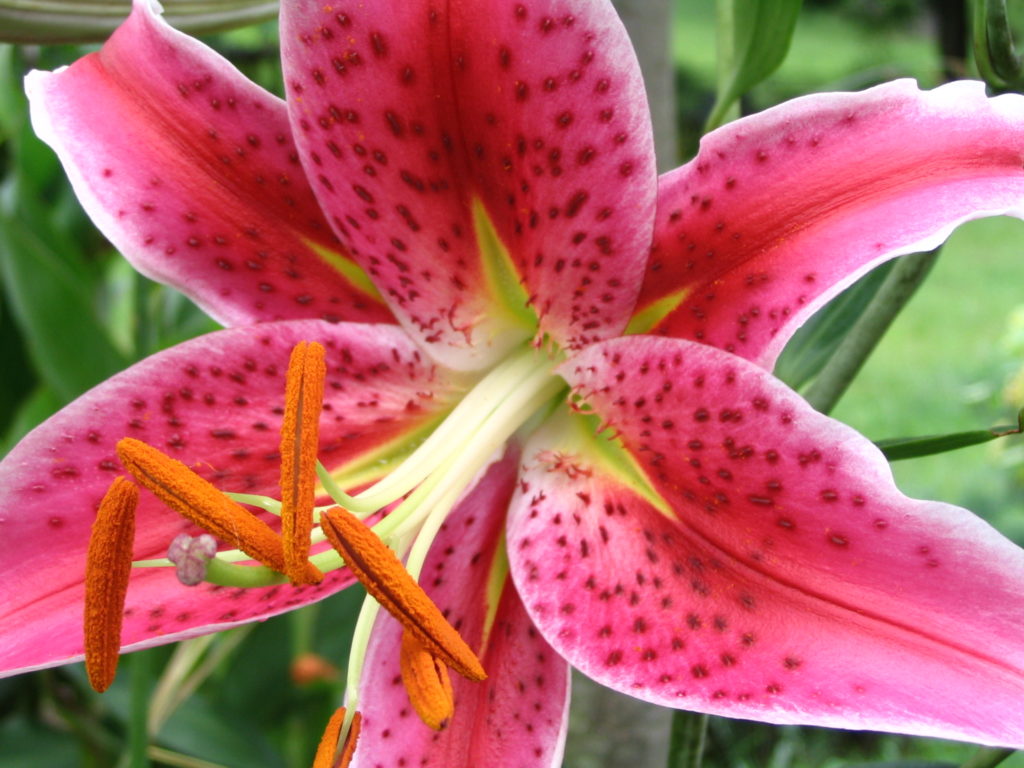
No Lilies for Cats
Lilies 101
Many different kinds of plants are found or sold with “lily” as part of their name. A few grow wild in ditches and wooded areas, some are sold as bulbs in garden shops, and many are used in floral arrangements. If you live with cats, it’s critical to know which lilies are toxic to your feline friend.
The Most Dangerous Lilies for Cats
The most dangerous and potentially fatal lilies for cats are those found in the genus Lilium and Hemerocallis. These beautiful and affordable flowers are often found in cut-flower bouquets or potted for the Easter holiday. If you have cats at home, it’s critical that you do not bring these flowers inside.
- Asiatic lily – including hybrids (Lilium asiatica)
- Daylily (Hemerocallis species)
- Easter lily (Lilium longiflorum)
- Japanese Show lily (Lilium speciosum)
- Rubrum lily (Lilium speciosum var. rubrum)
- Stargazer lily (Lilium ‘Stargazer’- a hybrid)
- Tiger lily (Lilium tigrinum or lancifolium)
- Wood lily (Lilium philadelphicum or umbellatum)
These beautiful and affordable flowers are often found in cut-flower bouquets or potted for the Easter holiday. If you have cats at home, it’s critical that you do not bring these flowers inside. The toxin has not been identified, but exposure to any part of the plant, including leaves, flowers, pollen, or even the water from the vase may result in acute kidney failure in cats. These ingestions are medical emergencies requiring immediate veterinary care. Early decontamination, aggressive intravenous fluid therapy, renal function tests, and supportive care greatly improve the cat’s prognosis. A delay of treatment of more than 18 hours after ingestion generally results in irreversible renal failure. Dogs may experience minor gastrointestinal upset after ingestion of these lilies but do not appear to develop kidney damage. If you have cats at home, it’s critical that you do not bring these flowers inside.
Safer Cut-Flower Alternatives
When buying flowers or ordering them for delivery, remember to ‘leave out the lilies!’ It’s advisable to specifically instruct florists not include any lilies in the Lilium species such as stargazer, Asiatic, Oriental, or tiger lilies. Giving florists the scientific name of the flower species can help avoid confusion.
Instead, consider these safer alternatives for cut flower arrangements and bouquets:
- Baby’s breath*
- Carnation*
- Daisy (Gerbera and others)
- Hyacinth*
- Iris*
- Chrysanthemum a.k.a. Mums*
- Orchid
- Peruvian Lily (Alstroemeria species)*
- Rose
- Spring crocus
- Snapdragon
- Sunflower
- Tulips*
- Zinnia
*These plants may cause more gastrointestinal irritation or upset (drooling, vomiting, and/or diarrhea) than others on the list but are not expected to cause severe poisoning (i.e. kidney, liver, or nervous system effects).
Other Highly Toxic Lilies
(risk to dogs, cats, and people)
Other types of dangerous “lily” plants include the lily of the valley (Convallaria majalis) and gloriosa or flame lily (Gloriosa superba). Lily of the valley contains cardenolides or digitalis like toxins which do not cause kidney failure, but may cause life-threatening cardiac arrhythmias and death when ingested by dogs, cats, or people. Equally toxic to all animals is the gloriosa lily. The toxic agent is colchicine (toxic to rapidly dividing cells); the roots or tubers may contain enough toxins to cause serious multi-system organ failure in cats and dogs that chew on them. Early and aggressive therapy is generally needed when these plants are ingested.
Less Harmful Lilies
(risk to dogs and cats)
Less serious consequences occur when pets chew or swallow plant pieces from “lilies” such as the calla lily (Zantedeschia spp.) and peace lily (Spathiphyllum spp.) which contain insoluble oxalate crystals that are direct irritants to the mouth, tongue, throat, and esophagus. Drooling, foaming, or pawing at the mouth, vocalization, and vomiting are commonly reported when pets chew on these plants; respiratory distress due to swelling of the airway can occur but is more rare. The Peruvian lily (Alstroemeria spp.) contains tulipalin A, a toxin that may cause gastrointestinal problems such as vomiting or diarrhea if ingested in large amounts. None of these lilies cause acute kidney failure in cats like the Lilium or Hemerocallis (daylily) species.
What to do if your pet eats a lily?
Cats and other pets consuming any part of a “lily” plant may need immediate veterinary medical care. In order to quickly assess the severity of the situation, pet owners should call Pet Poison Helpline (855-764-7661) or bring the animal and plant to their veterinarian as soon as possible. Early identification of the specific lily and appropriate treatment will usually prevent most undesirable outcomes.

